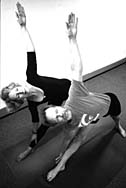
Photo by Ed Richardson
Comment
on this story
|
|

Yoga is Alignment
"Can I do my shoulderstand without a blanket?" I naively ask.
A strained silence ensues before the entire class reacts: "No!" "Why would you even want to?" "You should NEVER do that." "It's too dangerous!"
The teacher, Felix, is a little more restrained. "I'd rather that you didn't," he says, before explaining precisely why.
I might have gotten away with that in another class, but this is Iyengar yoga, a style concerned with precision alignment and safety—a yoga of details and rules that's become the most popular style of yoga in America, with both students and teachers (nearly all serious yoga teachers have had some Iyengar experience). Iyengar-style yoga classes have helped legions of students get in touch with their sitbones and inner thighs and psoas muscles. It's the style that spawned a thousand exercise videos—including the best-selling Living Arts series featuring Patricia Walden and yoga-celeb Rodney Yee. And it introduced the world to the concept of yoga props—blocks and mats and straps and blankets for shoulderstands.
There's a good reason for the popularity of Iyengar style: It teaches you not just what to do, but how to do it—exactly. "Iyengar is famous for precision and alignment—for attending to the details and the subtleties of the poses" says Felix. "So we learn that this muscle is connected to that muscle and if we loosen this muscle then we get deeper into the pose."
Though the focus in Iyengar is on alignment and form, the goal is self-acceptance—which, though they may seem mutually exclusive at times, really aren't. "If you show up in yoga and you have tight hips and you can't do some poses, you have to learn to be very gentle and diplomatic with yourself to accept it," he says. "And there's a part of what the Western culture gets from yoga, because we're all used to getting there by struggling. I think our whole society is designed around struggling. Therefore, yoga is the opposite—using relaxation to get there, but also accepting if you don't get there, because you don't have to get anywhere."
That is, to KYC instructor Ellen Stinnett, 46, one of yoga's most important lessons. "At first, being an athlete, I was more interested in doing perfect poses and in the physical aspects of yoga," she says. "But as I studied it more and more, I became very attuned to how my body felt on the inside, and my mind felt on the inside. To me, yoga has always been like peeling away layers of an onion. Most people start off learning the postures. The deeper you allow yourself to go into it, you begin to realize the more internal aspects are there."
The entire Iyengar system, explains Felix, might be viewed as a series of stepping toward uncovering more and more of these internal aspects. "According to Mr. Iyengar, the purpose of hatha yoga is to condition and prepare the body for the breathwork, and for the meditation," he says. "The idea is for you to find a way to get where you want to go. I could just sit here and meditate, but at 70 years old, my body might not be in the shape I want it to be in—so I do the physical. But who cares how you get there? Just get there."


|